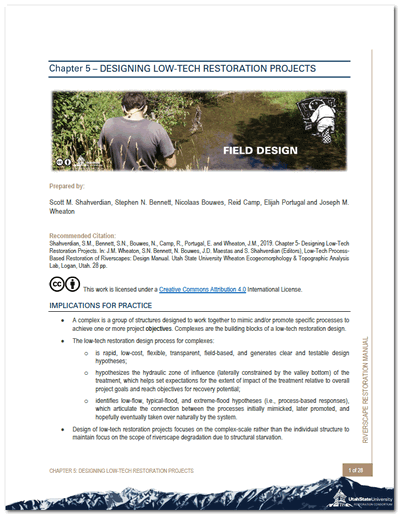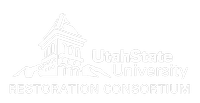Chapter 5: Designing Low-Tech Restoration Projects
 The fifth chapter covers the low-tech process-based restoration design processl. This process is generic to desiging any type of low-tech process-based restoration treatment (not just PALS & BDAs). Speifically, the following topics are covered:
The fifth chapter covers the low-tech process-based restoration design processl. This process is generic to desiging any type of low-tech process-based restoration treatment (not just PALS & BDAs). Speifically, the following topics are covered:
- Key Principles for Designing Low-Tech Restoration Projects
- Getting Started – Design and Required Information
- A Low-Tech Design Plan
- Design of a Complex
- Considerations for Common Complex Objectives
- The Importance of Time and Flow Conditions
Chapter 5 also has an appendices on:
- Appendix A: The Topographic Paradox
 Full PDF available for free at ResearchGate, but ResearchGate requires a free account.
Full PDF available for free at ResearchGate, but ResearchGate requires a free account.
Implications for Practice
- A complex is a group of structures designed to work together to mimic and/or promote specific processes to achieve one or more project objectives. Complexes are the building blocks of a low-tech restoration design.
- The low-tech restoration design process for complexes:
- is rapid, low-cost, flexible, transparent, field-based, and generates clear and testable design hypotheses;
- hypothesizes the hydraulic zone of influence (laterally constrained by the valley bottom) of the treatment, which helps set expectations for the extent of impact of the treatment relative to overall project goals and reach objectives for recovery potential;
- identifies low-flow, typical-flood, and extreme-flood hypotheses (i.e., process-based responses), which articulate the connection between the processes initially mimicked, later promoted, and hopefully eventually taken over naturally by the system.
- Design of low-tech restoration projects focuses on the complex-scale rather than the individual structure to maintain focus on the scope of riverscape degradation due to structural starvation.
- The number of structures in a complex varies but is typically between 2 - 15 structures. The objectives of adjacent complexes can be the same or different depending on project goals and reach-scale recovery potential.
- Learning can be maximized and subsequent improvements, innovations and refinements to design and later phases of treatment or maintenance will be more informed when the low-tech process-based restoration designer articulates clear, testable design hypotheses at the complex-scale.
Recommended Citation
- Shahverdian, S.M., Bennett, S.N., Bouwes, N., Camp, R., Portugal, E. and Wheaton, J.M. 2019. Chapter 5- Designing Low-Tech Restoration Projects. In: J.M. Wheaton, S.N. Bennett, N. Bouwes, J.D. Maestas and S.M. Shahverdian (Editors), Low-Tech Process-Based Restoration of Riverscapes: Design Manual. Utah State University Wheaton Restoration Consortium, Logan, Utah. 28 pp. DOI: 10.13140/RG.2.2.11621.45286
Minimum Viable Design Package

Related Resources



 Low-Tech PBR Recipes
Low-Tech PBR Recipes